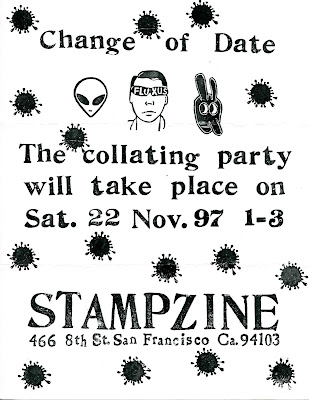 |
| Call for works for Stampzine #6, 2000 |
 |
| Stampzine #1, 1995 |
 |
| Stampzine #1, 1995 (inside pages) |
 |
| Stampzine #2, 1996 |
 | |
|
 |
| Stampzine #2, 1996 (inside pages) |
 |
| Stampzine #3, 1997 |
 |
| Stampzine #3, 1997 (inside pages) |
 |
| Stampzine (l-r):#5, 1999, #6, 2000, #4, 1998 |
 |
| Stampzine (l-r):#6, 2000, #5, 1999, #4, 1998 |
 |
| Stampzine (insides pages from above three issues) |
Stampzine
This interview with Bill Gaglione, editor of Stampzine, took place in San Francisco
in 1995. Six issues of Stampzine were published between 1995-2000.
___________________________________________________________________________________________
Stephen
Perkins: One thing that I am really
interested in is assembling magazines and you did a Vile assembling, was that the first one you'd done?
Bill
Gaglione: I think so...
SP: You adopted the assembling technique because it was
the best way of working...
BG: I had just got back from Europe and I was in
Eastern countries and I saw what was going on, they were doing those type of
magazines, I was aware of that, but I saw a lot of it, and I said wow! Again it was the money factor, who
had to money to publish? So it was a nice way to put a publication together.
SP: So you connect assemblings with the former Eastern
bloc countries?
BG: Most of the publications that I saw there were
assembling type publications, so I was really influenced by that. In 1970 we
toured Eastern Europe.
SP: Which magazines?
BG: Off hand I can't remember, they were so obscure.
Pawel Petasz type magazines or rubber stamp magazines. Galantai in Budapest, he
showed me a lot of stuff. Again when I got back I said I wanted to do an issue
of Vile, but I don't want to go
through the hassle of getting the grant, actually Anna did most of that. And I
wanted to do color and it was strictly rubber stamps and it was a weird size. I
got to give credit 'cause I had to cut each page 300 times and then stamp it
300 times. It's a really nice issue, it's thick, it's huge, I think 185 artists
sent pages. Another aspect of assemblings was that I liked the collating,
because I used to call all my friends and it's a nice social way to get
together, instead of just sitting there drinking and getting stoned, which we
did, but we worked and it was fun. Especially that one, it took us all day, I
had about 50 people. My friend was a teacher at a school and we laid these
tables out and we walked around and we had food and drink, it was really fun.
So that aspect was really nice also, plus it's inexpensive, because basically
you design the cover and your course is basically putting it together and
mailing it out, and you have to do that anyway. Plus you can do color, limited
edition, also that's another reason why I liked this concept.
SP: In the sense of?
BG: That it's limited. Once it goes, it goes. Also,
whoever contributed got a free issue that was a nice way of distributing that
book.
SP: So had you contributed to assemblings before?
BG: Oh yea, Kostelanetz, a lot of stuff in Europe, all
through my sort of quote "mail art career." I've liked them the best
'cause I always used rubber stamps, it's a real home made feel, real artsy
fartsy.
I've got to hand it to Kostelanetz 'cause he really
did a lot of them. Then I did a magazine called Stamp Art in the '80s. It was the same thing, they were all hand
stamped, that was my only requirement, I told people you can do anything you
want but each page has to be hand stamped at least once, and the rest you could
do anything you want.
Now you might find the cover interesting [picking up
a copy of Stamp Art]. This is the
first four color stamp ever made, and it was basically a photograph and we got
the separations made our of rubber instead of... So we did five issues there, Vile and then they called us stamp art.
Eventually I will mail you a copy. So that's the only two assembling-type
magazines that I did and I'm thinking about doing another in the '90s. I'm
helping a woman called Patricia to do one now, she's doing an assembling-type where
you mail in 50 copies, so I have been involved with that.
